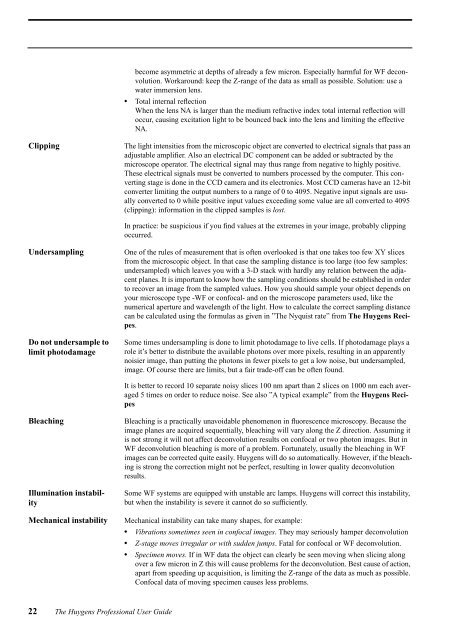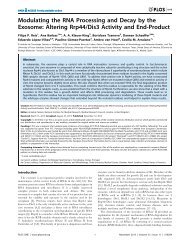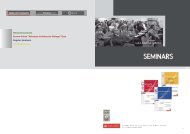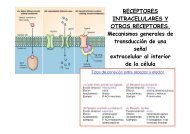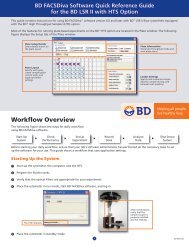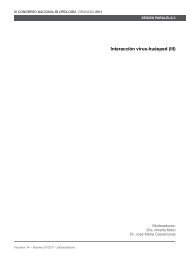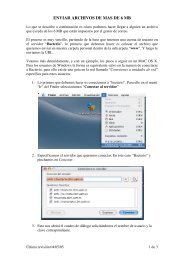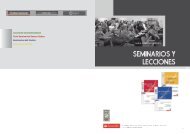Huygens Professional User Guide
Huygens Professional User Guide
Huygens Professional User Guide
You also want an ePaper? Increase the reach of your titles
YUMPU automatically turns print PDFs into web optimized ePapers that Google loves.
ecome asymmetric at depths of already a few micron. Especially harmful for WF deconvolution.Workaround: keep the Z-range of the data as small as possible. Solution: use awater immersion lens.• Total internal reflectionWhen the lens NA is larger than the medium refractive index total internal reflection willoccur, causing excitation light to be bounced back into the lens and limiting the effectiveNA.ClippingThe light intensities from the microscopic object are converted to electrical signals that pass anadjustable amplifier. Also an electrical DC component can be added or subtracted by themicroscope operator. The electrical signal may thus range from negative to highly positive.These electrical signals must be converted to numbers processed by the computer. This convertingstage is done in the CCD camera and its electronics. Most CCD cameras have an 12-bitconverter limiting the output numbers to a range of 0 to 4095. Negative input signals are usuallyconverted to 0 while positive input values exceeding some value are all converted to 4095(clipping): information in the clipped samples is lost.In practice: be suspicious if you find values at the extremes in your image, probably clippingoccurred.UndersamplingDo not undersample tolimit photodamageOne of the rules of measurement that is often overlooked is that one takes too few XY slicesfrom the microscopic object. In that case the sampling distance is too large (too few samples:undersampled) which leaves you with a 3-D stack with hardly any relation between the adjacentplanes. It is important to know how the sampling conditions should be established in orderto recover an image from the sampled values. How you should sample your object depends onyour microscope type -WF or confocal- and on the microscope parameters used, like thenumerical aperture and wavelength of the light. How to calculate the correct sampling distancecan be calculated using the formulas as given in ”The Nyquist rate” from The <strong>Huygens</strong> Recipes.Some times undersampling is done to limit photodamage to live cells. If photodamage plays arole it’s better to distribute the available photons over more pixels, resulting in an apparentlynoisier image, than putting the photons in fewer pixels to get a low noise, but undersampled,image. Of course there are limits, but a fair trade-off can be often found.It is better to record 10 separate noisy slices 100 nm apart than 2 slices on 1000 nm each averaged5 times on order to reduce noise. See also ”A typical example” from the <strong>Huygens</strong> RecipesBleachingIllumination instabilityMechanical instabilityBleaching is a practically unavoidable phenomenon in fluorescence microscopy. Because theimage planes are acquired sequentially, bleaching will vary along the Z direction. Assuming itis not strong it will not affect deconvolution results on confocal or two photon images. But inWF deconvolution bleaching is more of a problem. Fortunately, usually the bleaching in WFimages can be corrected quite easily. <strong>Huygens</strong> will do so automatically. However, if the bleachingis strong the correction might not be perfect, resulting in lower quality deconvolutionresults.Some WF systems are equipped with unstable arc lamps. <strong>Huygens</strong> will correct this instability,but when the instability is severe it cannot do so sufficiently.Mechanical instability can take many shapes, for example:• Vibrations sometimes seen in confocal images. They may seriously hamper deconvolution• Z-stage moves irregular or with sudden jumps. Fatal for confocal or WF deconvolution.• Specimen moves. If in WF data the object can clearly be seen moving when slicing alongover a few micron in Z this will cause problems for the deconvolution. Best cause of action,apart from speeding up acquisition, is limiting the Z-range of the data as much as possible.Confocal data of moving specimen causes less problems.22 The <strong>Huygens</strong> <strong>Professional</strong> <strong>User</strong> <strong>Guide</strong>


